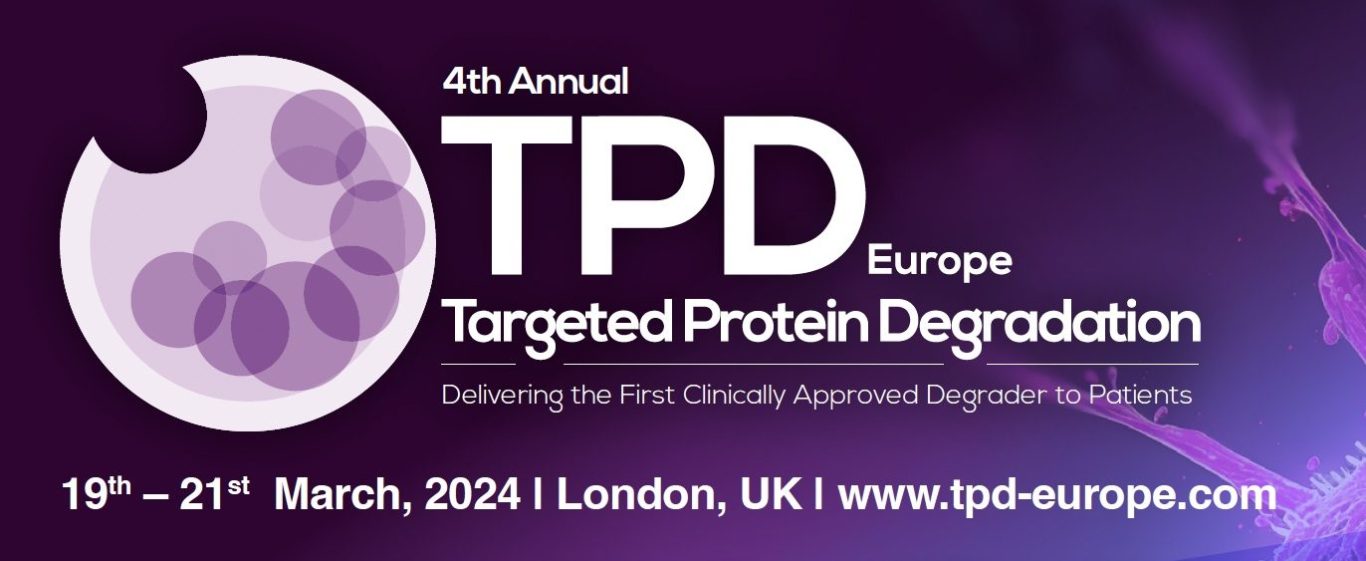TPD Conferences Update - and TPD Europe (20-21st March) summary
26th March 2024

Conference season is now in full swing and there’s plenty of opportunities to keep up to date with the latest in TPD & Induced-Proximity drug discovery work as well as catch up with colleagues at the wide range of meetings across Europe and the US. I’ve updated the conference page on my website so there’s now 13 TPD-focused conferences (not including the specialist sessions at ACS, AACR etc) in 2024. If there’s others I’ve missed please let me know and I’ll add.
I had the pleasure of chairing a number of sessions at last week’s TPD Europe meeting held in Kensington, London but for those of you not able to attend, I’ve summarised a few of my personal highlights below.
The meeting had two tracks and, as I was chairing track B, I didn’t get to see the Track A talks - there were also lots of other great talks I don’t have space to describe here so many apologies to all the speakers I have not included below!
Kristin Riching from Promega reminded us of the assortment of useful assay systems Promega have developed to address a wide range of bifunctional pharmacology-related questions.
One nice example focused on degraders of the cell surface kinase EGFR (see my blog here for more info in this area). Using an EGFR HiBit construct with an extracellular HiBit, Kirsten described an assay system able to measure the rate of internalisation of the receptor. Using an analogous EGFR HiBit tagged on the intracellular face gave an assay which quantitated the degradation. Putting them together showed complete internalisation of receptor in ~5h but complete degradation required closer to 10h – a nice kinetic demonstration the two stage process often required for degradation of cell surface targets which is frequently slower than with PROTACs/glues.
There was also a nice discussion about impact of HiBit tagging of proteins of interest (POIs) on degradation. Although HiBit contains 2 lysines which in principle could facilitate degradation if ubiquitylated, these can be mutated to arginine with no change in degradation rate suggesting they are not themselves ubiquitylated. There have also been reports that HiBit-tagging may increase the basal turnover rate of the POI, making it more difficult to degrade efficiently. Whilst it may be prudent to check this for new HiBit lines, Kirsten felt it is likely not a general effect though may be seen with some overexpressed systems.
Kirsten McAuley from the CeTPD in Dundee shared some sobering lessons from their recent preprint describing an unsuccessful screening campaign to find degraders of the cancer target CRAF.
Although many hits were seen from the initial screen, all fell away for a range of reasons which those in the TPD field would be well advised to look for.
A series of CRBN-based degraders showed potent degradation though with a lag of ~4 hours before the onset of degradation. Detective work showed that the apparent degradation was actually caused by GSPT1 degradation (a well-known CRBN glue off target) which shuts down transcription and thus will seem to lower the level of any short-lived protein. Indeed, use of a GSPT1 degrader gives a cellular signature very similar to cycloheximide, the frequently used protein synthesis inhibitor control.
Other “hit” degraders also showed delayed degradation, with onset only after ~12 hours. Further detective work showed this to simple be a toxicity effect though cytotoxicity only became clear using standard assays after 72h, suggesting the cells were sick well before then and downregulated protein synthesis as a stress response.
Fortunately, there are simple ways to check for these kinds of false positives. To look for general protein synthesis downregulation, consider checking levels of a control target like MCL1 or other short-lived protein. Also, adding excess of free POI ligand should fully ablate the observed degradation working through bona fide PROTAC MoA – if it doesn’t, it’s a sign that something more complex, and potentially more unwanted, may be going on. Also, be aware of any toxicity, even if seen at longer timepoints or higher concentration, as it could be confounding. Remember as well of course – if your degrader is showing effects quickly (eg <3 hours) then there’s less chance of undesirable things going on.
Congratulations on the Dundee team for publishing this “failed” screen which may actually provide a lot more utility to the field than publication of other, apparently “successful” screens!
Markus Schade from AZ discussed how to optimise oral bioavailability of PROTACs (see my discussion on this topic here) and which systems to use to measure this. The profile of the BTK PROTAC NX-2127 (%F mouse = 37%, rat = 7%, dog & monkey ~1%) showed how species differences can cause issues, especially when thinking about safety assessment (formulation issues can help here of course).
Many PROTACs suffer poor oral availability due to poor absorption. Various publications have highlighted the need to reduce the number of highly solvated or “unsatisfied” hydrogen bond donors (HBDs) to maintain good membrane permeability and Markus showed a variable temperature NMR method which compared NH shifts in DMSO (to mimic aqueous) vs CDCl3 (to mimic membrane polarity) to see which ones are strongly solvated vs involved in a full intramolecular H-bond/strong dipole interaction or are “shielded” and which of these vary in a “chameleonic” nature between solution and membrane. This latter concept of sterically shielding HBDs has been used to good effect to increase membrane permeability and subsequently oral bioavailability. Up to 2 highly solvated HBDs can still be tolerated though 3 makes things much more challenging. The NMR methods may offer similar conclusions to the chromatographic EPSA measurements may have a wider dynamic range.
Shawn Schiller from Foghorn summarised how they identified highly potent CBP PROTACs with good selectivity over EP300. This is important as dual inhibitors (and likely degraders) of the highly homologous targets CBP & EP300 have been associated with clinical adverse effects including thrombocytopenia so selectivity could be a key advantage. In exploratory safety studies, the selective CBP degraders showed a much-reduced risk for thrombocytopenia, showing how degraders can deliver safety/efficacy profiles not easily achievable with inhibitors. Shawn also reminded us that even selective degraders can still inhibit off targets which can lead to issues so, during optimisation they managed to reduce binding affinity (and inhibition) to both CBP & EP300 while maintaining potent CBP degradation. Nice work!
Swen Hoelder from ICR, Sutton gave an intriguing story around BCL6 inhibition/degradation. The project started life as an inhibitor effort and indeed good inhibitors could be optimised but soon, strange assay data alerted the team to the fact that some analogs also potently degraded BCL6. In some of the most striking SAR, potent BCL6 inhibitors with a morpholine substituent showed no degradation (DC50>10uM) but a simple change to a difluoropiperidine gave a 50nM DC50 degrader. Using chiral dimethyl piperidines, only one stereoisomer showed degradation inferring a highly specific mechanism though the team have so far been unable to definitively tie down the mechanism via siRNA and BioID studies. Intruigingly, some studies suggest the degradation may be ubiquitin-independent though there could be more twists as more data emerge I suspect!
Graham Simpson from Dunad described their use of electrophilic tags to identify new, monovalent degraders. Covalency is seeing somewhat of a renaissance in drug discovery, a fact amply demonstrated by the approval of the aldehyde-containing drug Voxelotor to treat sickle cell disease at a dose of 1500mg/day!
Using the Dunad proprietary 10,000 strong compound set together with whole proteome cysteine proteomics, the team were able to identify a large number of tractable targets and binders. Presumably, while some of the hits gave good degraders, others were just inhibitors or even silent binders – all of which could be useful for a range of TPD and induced-proximity applications.
Simon Glerup from Danish biotech DraupnirBio described a new mechanism for degradation of cell surface or extracellular targets. Using bifunctional agents, known as SORTACs, incorporating binders to the sortilin receptor, good degradation of targets including IgG & TNFa was shown (NB a sortilin antibody is in Phase III clinical studies so presumably modulating this target is unlikely to cause any safety issues)
Interestingly, although SORTACs enable ternary complex formation, they act as more of a carrier of the substrate rather than having to enable eg highly specific ubiquitin transfer as with PROTACs or glues – will this translate to simpler SAR in optimisation? We’ll need to wait and see.
The meeting was wrapped up with an excellent talk by Ollie Hsai from the Dundee CeTPD team who recounted the discovery published recently in Nature of the intramolecular bivalent glue (IBG) concept whereby bivalent sulfonamide-based degraders (originally thought to engage DCAF15) bind two adjacent bromodomains on BRD4 to create a neo-interface able to recruit the E3 ligase DCAF16. It appears that the IBG degrader fixes BRD4 in an abnormal conformation (an “eat me” degron?) which may present it as a damaged or aberrant protein which is then recognised by housekeeping ligases from the DCAF family for removal. Some neat med chem then produced 10pM DC50 degraders showing the exquisite potency of this mechanism. Interestingly DCAF16 has a weak basal affinity for BRD4 which the IBG degraders take advantage of as non-classical glues. Indeed, BRD4 is known to interact with a wide range of regulatory proteins, perhaps one of the reasons it is so easy to degrade? (NB - see the related recent J Med Chem paper from AZ who have also been investigating this series of molecules!)
A great meeting and thanks to the speakers and for Quinn et al at HansonWade for organising. Looking forward to my next conference trip already – hope to see some of you on the circuit.
We need your consent to load the translations
We use a third-party service to translate the website content that may collect data about your activity. Please review the details in the privacy policy and accept the service to view the translations.

